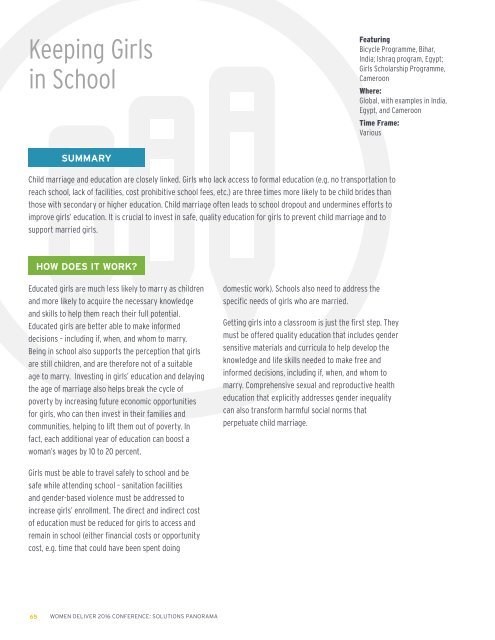Solutions Panorama
A collection of 100 programs, initiatives, and strategies that were shared at the Women Deliver 2016 Conference.
A collection of 100 programs, initiatives, and strategies that were shared at the Women Deliver 2016 Conference.
You also want an ePaper? Increase the reach of your titles
YUMPU automatically turns print PDFs into web optimized ePapers that Google loves.
Keeping Girls<br />
in School<br />
Featuring<br />
Bicycle Programme, Bihar,<br />
India; Ishraq program, Egypt;<br />
Girls Scholarship Programme,<br />
Cameroon<br />
Where:<br />
Global, with examples in India,<br />
Egypt, and Cameroon<br />
Time Frame:<br />
Various<br />
SUMMARY<br />
Child marriage and education are closely linked. Girls who lack access to formal education (e.g. no transportation to<br />
reach school, lack of facilities, cost prohibitive school fees, etc.) are three times more likely to be child brides than<br />
those with secondary or higher education. Child marriage often leads to school dropout and undermines efforts to<br />
improve girls’ education. It is crucial to invest in safe, quality education for girls to prevent child marriage and to<br />
support married girls.<br />
HOW DOES IT WORK?<br />
Educated girls are much less likely to marry as children<br />
and more likely to acquire the necessary knowledge<br />
and skills to help them reach their full potential.<br />
Educated girls are better able to make informed<br />
decisions – including if, when, and whom to marry.<br />
Being in school also supports the perception that girls<br />
are still children, and are therefore not of a suitable<br />
age to marry. Investing in girls’ education and delaying<br />
the age of marriage also helps break the cycle of<br />
poverty by increasing future economic opportunities<br />
for girls, who can then invest in their families and<br />
communities, helping to lift them out of poverty. In<br />
fact, each additional year of education can boost a<br />
woman’s wages by 10 to 20 percent.<br />
domestic work). Schools also need to address the<br />
specific needs of girls who are married.<br />
Getting girls into a classroom is just the first step. They<br />
must be offered quality education that includes gender<br />
sensitive materials and curricula to help develop the<br />
knowledge and life skills needed to make free and<br />
informed decisions, including if, when, and whom to<br />
marry. Comprehensive sexual and reproductive health<br />
education that explicitly addresses gender inequality<br />
can also transform harmful social norms that<br />
perpetuate child marriage.<br />
Girls must be able to travel safely to school and be<br />
safe while attending school – sanitation facilities<br />
and gender-based violence must be addressed to<br />
increase girls’ enrollment. The direct and indirect cost<br />
of education must be reduced for girls to access and<br />
remain in school (either financial costs or opportunity<br />
cost, e.g. time that could have been spent doing<br />
65<br />
WOMEN DELIVER 2016 CONFERENCE: SOLUTIONS PANORAMA



